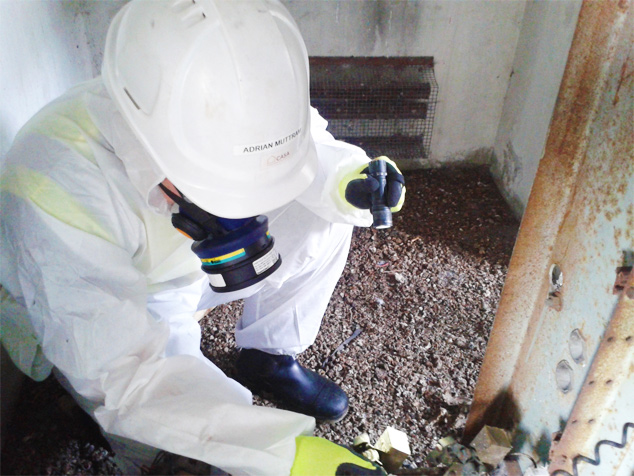Asbestos Testing – The Ultimate Guide to Asbestos Testing
How to Arrange Testing of Materials Suspected of Containing Asbestos
If you have a material suspected of containing asbestos a representative sample can be taken for analysis and testing to determine whether asbestos is present or otherwise.
Asbestos is a naturally occurring mineral that has had a wide range of uses over a long period of time. Due to its properties of fire and electrical resistance, insulation, availability and cheapness it became very popular and was used extensively in the construction industry across the globe. It was used in a multitude of ways including in ceiling tiles, insulation, flooring and textured coatings to name just a few examples.
In the late 20th century however asbestos exposure was discovered to be the cause of a number of serious health problems –
- Asbestosis – A chronic respiratory disease initiated by inflamed asbestos fibres aggravating the lung tissues. This can result scarring of the lungs and in its advanced stages can lead to cardiac failure.
- Lung Cancer – This condition is responsible for the largest number of deaths related to asbestos exposure.
- Mesothelioma – A rare form of cancer that typically occurs in the thin membrane lining of the lungs, chest, abdomen and sometimes the heart. Find out more about mesothelioma here.
- Pleural Thickening – Thickening and swelling of the lining of the lungs.
The use of Asbestos was banned in the UK in 1999 but as it was used so extensively it is still present in many buildings built before this time.
How to Test for Asbestos
As asbestos is such a harmful material and exposure to it can be fatal it is absolutely vital that you utilise a professional and accredited asbestos testing company such as Casa Environmental Services, to test any suspected asbestos containing materials (ACMs). It is recommended you avoid taking samples for analysis yourself as unless you are qualified and experienced in dealing with asbestos you could be putting yourself and other occupants of the building at risk of exposure.
Asbestos fibres are microscopic and are invisible to the naked eye. They are often mixed in a matrix of other materials which may make identification more difficult.
Analysis of suspected asbestos containing materials can only be undertaken by Laboratories that have been accredited to do so by the United Kingdom Accreditation Service.
The usual method of detection is undertaken using a Polarised Light Microscope and Dispersion Staining Techniques by BOHS P401 qualified Analysts.
See more: UKAS Accreditation and Asbestos – Everything You Need to Know About UKAS and Asbestos
How is Asbestos Testing Performed?
The first step involved in the asbestos testing process is to arrange for an asbestos survey to be carried out at your property. Different types of surveys are available –
- Asbestos Management Survey – This is the standard type of survey and is conducted during normal operation (when no planned works are due to be undertaken).
- Refurbishment and Demolition Survey – These types of surveys are carried out prior to any planned demolition or refurbishment work. They are more intrusive than management surveys and may involve damaging the fabric of the building to gain access to suspect
- Re-inspection Survey – These are carried out at regular pre-determined intervals so that the condition of known ACMs can be closely monitored.
The surveyors will take samples of any suspected ACMs which will then be sent to an authorised laboratory for analysis and testing. At the lab the testing company will be able to determine the type or types of asbestos present and indicate if asbestos is present in major, minor or trace elements.
The surveyor taking the sample on site can also determine how much of a hazard , if any, the asbestos containing material represents.
What if Asbestos is Found in My Home or Workplace?
If the sampled materials do in fact contain asbestos then the approach to managing it will be largely influenced by its condition. If the material is in a sound condition and is undamaged it is unlikely to represent an immediate threat to your health and can often be left in situ . In these circumstances the material should be monitored on a regular basis to ensure it has not deteriorated and become dangerous. It is only when the material is disturbed that it becomes dangerous as this can lead to potential fibre release into the air where they can then become respirable.
If the ACM is degrading, broken or crumbling remedial measures will need to be taken to mitigate the possibility of fibre release. This could involve removal or encapsulation (sealing) of the material. Under Regulation 4 (Duty to Manage) of the Control of Asbestos and Regulations 2012 legal all duty holders of buildings containing asbestos are legally obliged to demonstrate that the asbestos is being managed safely and effectively. Here at Casa Environmental Services, we can assist you in the compilation of a risk assessment and management plan in accordance with guidelines issued by the Health and Safety Executive (HSE) for working with ACMs. This will highlight the potential for asbestos exposure and dictate what methods are required to provide an effective control of the risks.
Accredited Asbestos Testing UK
If you’re looking to identify whether asbestos is present in your property please don’t hesitate to get in touch with a member of the Casa Environmental Services team today. We are accredited by UKAS to ISO17025 (ref:7914) to undertake bulk analysis of samples in our laboratory. We offer competitive rates and fast turnaround times with the majority of sample results being available the next day.
We’re also extremely proud to be accredited members of the ATaC, the Asbestos Testing and Consultancy Association providing our clients with confidence that we are a trusted and professional organisation that’s entirely committed to quality and service.
See more: Asbestos in Homes – A Homeowner’s Guide to Asbestos and What to Do
See more: Asbestos Awareness Training – Everything You Need to Know




